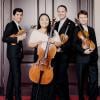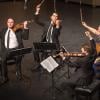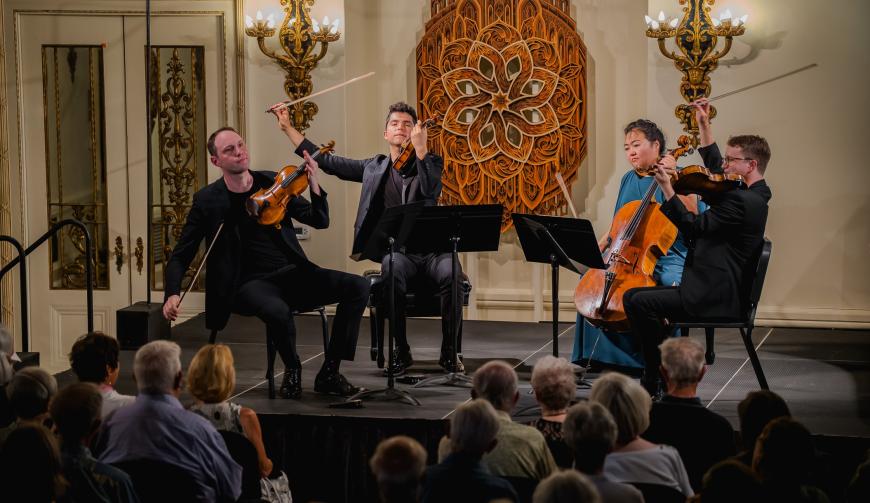
It’s always a joy to experience a concert played by people who clearly adore the music they’re performing. Stagnant summer air suddenly becomes charged with electricity. Audience members, of course, can tell and inch closer to the edge of their seats, captivated by each note.
Such was the case last Sunday afternoon, when the Calidore String Quartet performed Beethoven’s first three string quartets with unbridled enthusiasm. It was the first of six Music@Menlo concerts this summer that will span all 16 of Beethoven’s string quartets — and the ambitious Calidores’ fourth time presenting the complete cycle.
“Our quartet is continually drawn to Beethoven’s music for the enduring relevance of his humanistic perspective,” the group’s members write in their program notes. “He was an artist who aimed to compose not for one portion of society, but rather to unite through our fundamental elements.” Playing the full quartet cycle is the musical equivalent of climbing Mount Everest, they continue: “[It] is a herculean endeavor physically, intellectually, and emotionally.”
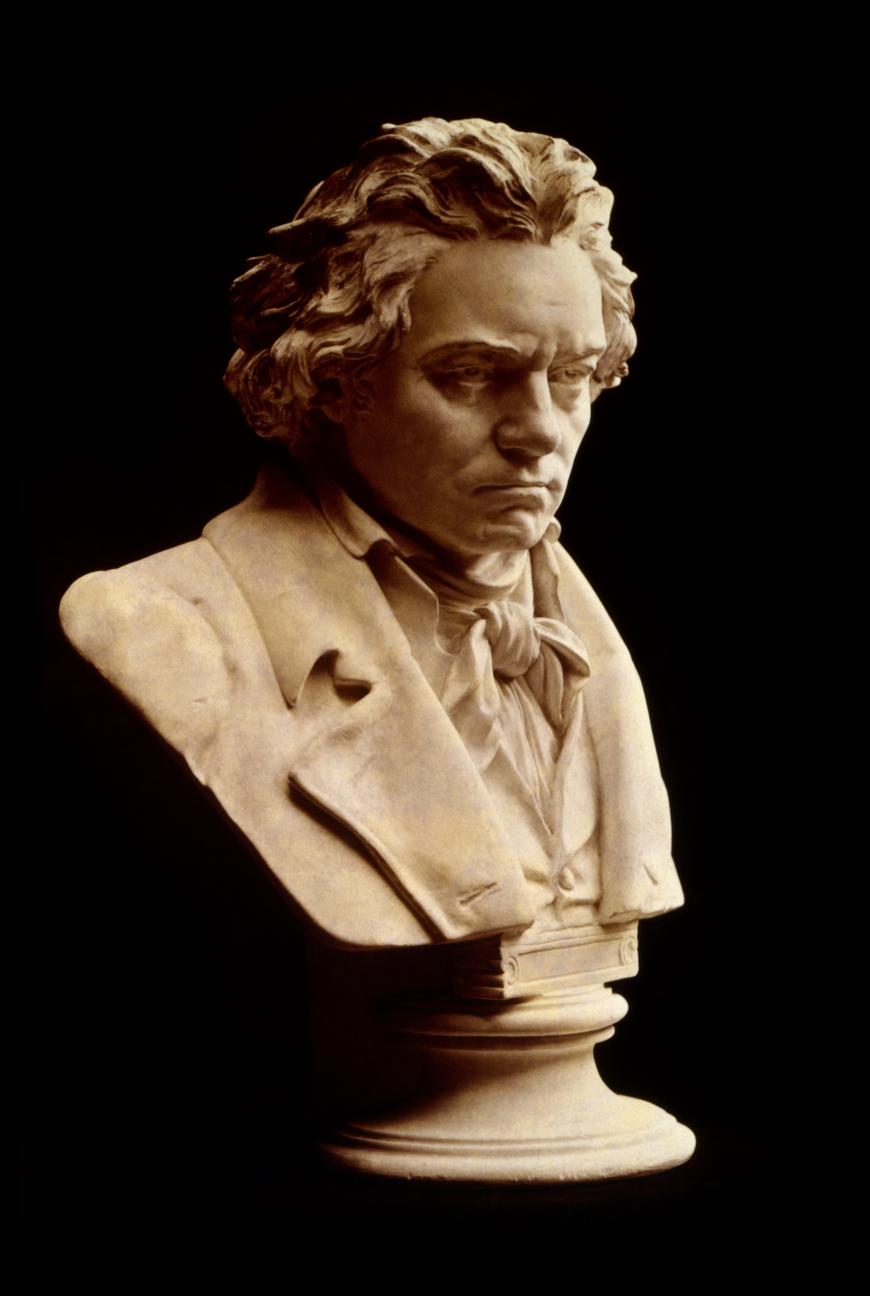
The Calidores’ deep reverence for and understanding of Beethoven’s music was apparent from the outset. The String Quartet in D Major, Op. 18, No. 3 (the first the composer wrote) opens with a sweet, yearning minor seventh in the first violin. When the rest of the group comes in, it’s as if a friend’s hand has been gently placed on your shoulder. The slow movement, quite Mozartian in its sound, was a delight, and the Calidores did a fine job of bringing out its conversational quality. The Presto finale was appropriately playful and giddy, and this performance could have made even the most stoic concertgoer feel the urge to nod his or her chin along with the beat.
The first movement of the String Quartet in F Major, Op. 18, No. 1 starts with a six-note motif: a turn figure that makes more than 100 appearances throughout the nine-minute movement.
The Adagio, said to have been inspired by the tragic tomb scene in Shakespeare’s Romeo and Juliet, brought out a different, darker side to the Calidores. It was in this movement that they delivered the afternoon’s most powerful moments: a gradual buildup in intensity as the sorrowful main theme was passed between the first violin and viola until it eventually culminated in the strike of a chord marked forte. This was followed by two pulses of silence. Another chord — marked piano. Silence. Yet another — marked pianissimo. Silence. One last chord — marked pianississimo. Silence.
Everyone, it seemed, held their breath during those pregnant pauses, which in the moment felt as if they lasted an eternity. (On a more technical note, this passage also showcased the Calidores’ impressive cohesion; each quarter note after a rest was flawlessly synchronized. Their cues are so subtle that if someone told me they had telepathic abilities, I’d believe it.)
Sure, there were a couple intonation slips in the first violin’s runs in this quartet, and sometimes, the sound got a bit hefty and aggressive. But if I’m going to listen to almost 90 minutes of music by a single composer, I’d much rather it be a vivacious, exciting journey — as it was here — than a clean but overly cautious one.
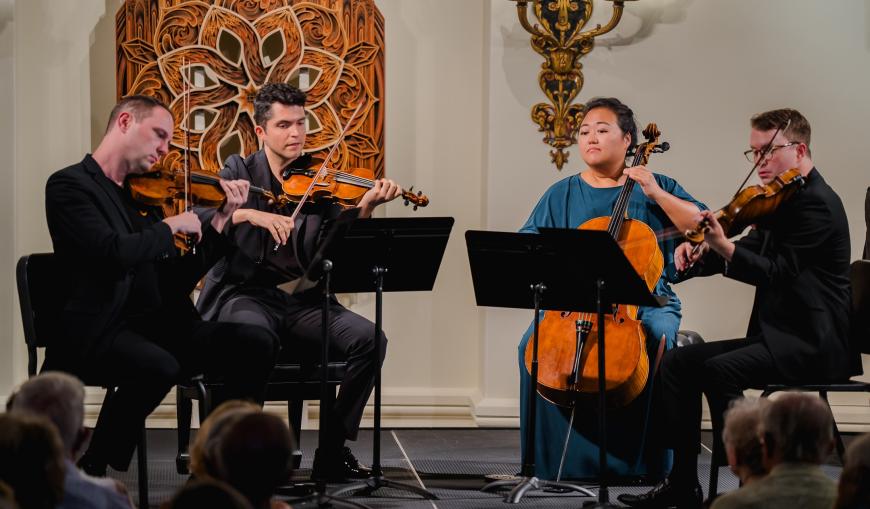
After a brief intermission, the Calidores continued with the String Quartet in G Major, Op. 18, No. 2. The dotted rhythms were nice and crisp and the dynamics honored, but overall, the first movement might have benefited from a greater sense of humor and irony. The second movement, a serene Adagio cantabile, is briefly interrupted by a teasing trio, which the Calidores plowed through hurriedly. The finale, which begins with an exchange of questions between the cello and the rest of the ensemble, was witty, high-spirited, and unpredictable throughout. You’re led to believe that the players are hurtling recklessly toward an explosive ending, but then — ha! — it’s actually a trick. The opening tune returns, leading us back to the real ending. The audience, delighted, leaped to its feet.
Formed at the Colburn School in 2010, the Calidore Quartet stands out for its members’ fearlessness and clear command of these three works. First violinist Jeffrey Myers is not one to shy away from a virtuosic passage; if anything, he tends to speed up a bit when he’s about to tackle one, as if he can’t possibly wait a second longer to show it off. Cellist Estelle Choi is the most expressive and outwardly communicative member, and her rich, resonant sound, especially in lower registers, provides a solid foundation for the others. Second violinist Ryan Meehan and violist Jeremy Berry are more understated, introverted performers but are both fundamental pillars of the group’s sound. Together, they make an effective ensemble.
If Sunday’s success is any indication of what’s to come, Beethoven fans who did manage to buy tickets to the Calidores’ following performances at Menlo’s Spieker Ballroom — the rare intimate venue in the Bay Area where you can hear chamber music as intended — are likely in for a treat.


